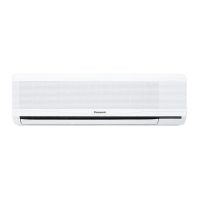
Do you have a question about the Panasonic CS-A28BKP5 and is the answer not in the manual?
| Brand | Panasonic |
|---|---|
| Model | CS-A28BKP5 |
| Category | Air Conditioner |
| Language | English |
Details remote control operations, modes, and settings.
Explains functions and indicators of the indoor unit.
Describes controls and functions of the outdoor unit.
Details the cooling operation, safety controls, and time saving.
Describes fan speed adjustments and operational timing during cooling.
Explains soft dry mode, safety controls, and fan speed.
Illustrates the timing of operations during soft dry mode.
Details heating operation, safety controls, and valve/fan behavior.
Describes fan speed adjustments and operational timing during heating.
Explains deicing procedures, overload control, and timing.
Details automatic mode selection, judgement criteria, and set temperatures.
Describes sleep mode for cooling/soft dry and heating operations.
Explains auto restart functionality and limitations.
Details manual and automatic fan speed settings.
Explains auto and manual airflow direction settings and adjustments.
Describes the function of the delay ON timer for different modes.
Explains cold draught control and fan speed behavior.
General safety warnings and prohibited actions before operating the unit.
Warnings and cautions regarding safe operation and handling of the unit.
Important cautions for unit usage, cleaning, and placement.
Identifies components of the indoor and outdoor units.
Lists included accessories and their functions.
Outlines the steps for preparing the unit before initial operation.
Provides temperature and humidity conditions for cooling and heating.
Explains auto restart function and suggests optimal temperature settings.
Describes automatic mode selection and the soft dry dehumidifying process.
Information on timer settings, power failure memory, and reset procedures.
Explains how to set and use sleep mode for comfort during rest.
Describes using auto operation button and managing remote signal sound.
Tips on adjusting temperature, cleaning filters, and ensuring proper airflow.
Cautions regarding cleaning agents and instructions for cleaning filters.
Addresses common normal operation scenarios and their explanations.
Warnings and guidelines for power cord connection, fuses, and safety.
Essential safety precautions and necessary tools for installation.
Cautions and considerations for installation location and power connection.
Lists accessories, piping data, and unit installation diagrams.
Covers selecting location, fixing plate, drilling holes, and installation steps.
Guides on bending piping, connecting cables, and handling covers.
Instructions for connecting cables, attaching bands, and installing filters.
Detailed steps for selecting location and installing the outdoor unit, including piping.
Procedures for cutting, flaring pipes, and evacuating the equipment.
Instructions for connecting outdoor unit cable and checking drainage/performance.
Guidance on insulating piping and checking performance.
Details valve positions for different operational and servicing tasks.
Steps for evacuating the system during initial installation.
Procedure for pumping down refrigerant before servicing or moving.
Procedure for evacuating the system during re-installation.
Steps for balancing refrigerant levels using 3-way valves.
Steps for evacuating the system when no refrigerant is present.
Procedure for charging refrigerant into the system after evacuation.
Details on disassembling indoor unit parts and inspecting electronic components.
Details on disassembling outdoor unit parts and inspecting electronic controller.
Procedures for resetting and changing remote control transmission codes.
Guides on diagnosing issues related to the refrigeration cycle.
Explains how pressure and current relate to unit conditions.
Methods for diagnosing faults in the compressor and 4-way valve.
Graphs showing thermostat behavior in different modes.
Performance data based on temperature and conditions.
How piping length affects performance in cooling and heating.
Part 1 of the electronic circuit schematic.
Part 2 of the electronic circuit schematic.
Part 3 of the electronic circuit schematic.

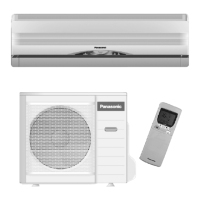





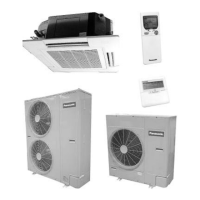

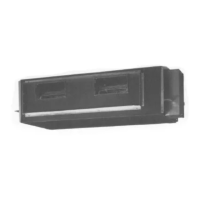

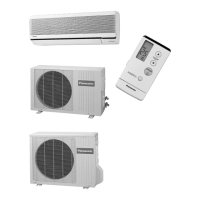
